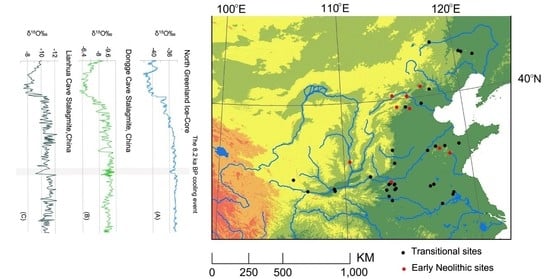The Climate Fluctuation of the 8.2 ka BP Cooling Event and the Transition into Neolithic Lifeways in North China
Abstract
1. Introduction
2. Materials and Methods
2.1. The Study Area and the Research Approach
2.2. Paleoclimate Fluctuation and the Paleolithic–Neolithic Transition in North China
2.3. Human Responses to the Impacts of Climatic Change
- (1)
- To increase mobility: This can be achieved as either expanding the foray distance or increasing the frequency of movement, or both [96]. Such a coping strategy could have enabled foragers to use a larger range of territory to procure resources and make up the deficiency of food resources in any confined areas, or reduce the resource pressures of any circumscribed regions [90,96].
- (2)
- To actively intensify the yields of food resources in the circumscribed area where the resources are relatively abundant or have a suitable environment for food production [87]: The surplus of the food resources usually went into storage and could be consumed later in lean seasons [97,98]. A substantial amount of effort and/or prerequisites are required to fulfill such a strategy, such as technological improvements, new inventions, part-time cultivation, and improved methods and investments for resource management [13,99,100]. Such requirements call for intensified investment in the circumscribed area and therefore people must have settled down and developed effective ways to defend the resources within their immediate territory [14].
- (3)
- To make long-distance migrations: Since environmental deterioration exerts impacts to varying degrees in different places, some areas might be less severely affected by climate change and might serve as destinations for migration [101]. Differing from the two strategies mentioned above, the migration strategy might have not necessarily required people to modify their adaption strategies since people could have still relied on past coping strategy by moving into the places where their past experience of subsistence strategy still fulfilled their needs [102]. However, since these destinations are usually not “empty”, the long-distance migration might have caused changes in social and cultural interaction, either reflected by inter-group conflict or amalgamation [103].
- (4)
- To develop social alliances and increase the intensity of social exchanges: This can increase reciprocal ties and buffer against subsistence risks [104]. This strategy is especially suitable in more heterogenous environments where the neighboring people may have relied on different subsistence bases and could have mutually complemented each other’s strategies through exchange [11].
3. Results
3.1. The “Transitional Remains” of the Early Holocene (11.5–8.5 ka BP)
3.2. Pioneering Changes in Coping Strategies Across the 8.2 ka BP Cooling Event in North China
3.2.1. The Jiahu Site
3.2.2. Shunshanji and Hanjing
3.2.3. Zhangmatun and Xihe
3.2.4. Cishan
3.2.5. Xiaohexi Remains
3.2.6. Nucleated Sedentism and Resource Intensification: An Innovative Coping Strategy Occurred in Multiple Sites but in Different Expressions
3.2.7. The Scarcity of the Archaeological Remains across North China and Its Implications
4. Discussion
4.1. Preexisting Cultural Preparations and the Path to the Neolithic Lifeway
4.2. The Impact of Climate Change Coping Strategies on the Thriving Development of Neolithic Culture
5. Conclusions
Supplementary Materials
Funding
Acknowledgments
Conflicts of Interest
References
- Shelach, G. The Development of Agriculture and Sedentary Life in North China. In The Archaeology of Early China: From Prehistory to the Han Dynasty; Shelach-Lavi, G., Ed.; Cambridge University Press: Cambridge, UK, 2015; pp. 68–102. [Google Scholar] [CrossRef]
- Chen, S.; Yu, P.-L. Early “Neolithics” of China: Variation and evolutionary implications. J. Anthropol. Res. 2017, 73, 149–180. [Google Scholar] [CrossRef]
- Zhao, Z. New Archaeobotanic Data for the Study of the Origins of Agriculture in China. Curr. Anthropol. 2011, 52, S295–S306. [Google Scholar] [CrossRef]
- Barton, L.W. Early Food Production in China’s Western Loess Plateau; University of California Davis: Davis, CA, USA, 2009. [Google Scholar]
- Shelach-Lavi, G.; Teng, M.; Goldsmith, Y.; Wachtel, I.; Stevens, C.J.; Marder, O.; Wan, X.; Wu, X.; Tu, D.; Shavit, R.; et al. Sedentism and plant cultivation in northeast China emerged during affluent conditions. PLoS ONE 2019, 14, e0218751. [Google Scholar] [CrossRef] [PubMed]
- Schettler, G.; Liu, Q.; Mingram, J.; Stebich, M.; Dulski, P. East-Asian monsoon variability between 15,000 and 2000 cal. yr BP recorded in varved sediments of Lake Sihailongwan (northeastern China, Long Gang volcanic field). Holocene 2006, 16, 1043–1057. [Google Scholar] [CrossRef]
- Xu, Q.; Xiao, J.; Li, Y.; Tian, F.; Takeshi, N. Pollen-based quantitative reconstruction of Holocene climate changes in the Daihai Lake Area, Inner Mongolia, China. J. Clim. 2010, 23, 2856–2868. [Google Scholar] [CrossRef]
- Wen, R.; Xiao, J.; Chang, Z.; Zhai, D.; Xu, Q.; Li, Y.; Itoh, S.; Lomtatidze, Z. Holocene climate changes in the mid-high-latitude-monsoon margin reflected by the pollen record from Hulun Lake, northeastern Inner Mongolia. Quat. Res. 2010, 73, 293–303. [Google Scholar] [CrossRef]
- Alley, R.B.; Mayewski, P.A.; Sowers, T.; Stuiver, M.; Taylor, K.C.; Clark, P.U. Holocene climatic instability: A prominent, widespread event 8200 yr ago. Geology 1997, 25, 483. [Google Scholar] [CrossRef]
- Rohling, E.J.; Pälike, H. Centennial-scale climate cooling with a sudden cold event around 8200 years ago. Nature (London) 2005, 434, 975–979. [Google Scholar] [CrossRef]
- Chen, S. The Prehistoric Modernization—An Ecological-based Exploration of the Process of Origin of Agriculture in China; China Science Publishing: Beijing, China, 2013. (In Chinese) [Google Scholar]
- Kelly, R.L. Mobility/Sedentism: Concepts, Archaeological Measures, and Effects. Annu. Rev. Anthropol. 1992, 21, 43–66. [Google Scholar] [CrossRef]
- Cleland, C.E. The Focal-Diffuse model: An evoluntionary perspective on the prehistorical cultural adaptions of the eastern United States. Midcont. J. Archaeol. 1976, 1, 59–76. [Google Scholar]
- Bar-Yosef, O.; Belfer-Cohen, A. The origins of sedentism and farming communities in the Levant. J. World Prehistory 1989, 3, 447–498. [Google Scholar] [CrossRef]
- Bender, B. Gatherer-hunter to farmer: A social perspective. World Archaeol. 1978, 10, 204–222. [Google Scholar] [CrossRef]
- Bandy, M.S.; Fox, J.R. Becoming Villagers: The Evolution of Early Village. In Becoming Villagers: Comparing Early Village Societies; Bandy, M.S., Fox, J.R., Eds.; The University of Arizona Press: Tucson, AZ, USA, 2010; pp. 1–16. [Google Scholar]
- Ren, M. The Compendium of Chinese Natural Geography; The Commercial Press: Beijing, China, 1999; ISBN 9787100026277. (In Chinese) [Google Scholar]
- Cohen, D.J. The beginnings of agriculture in China: A multiregional view. Curr. Anthropol. 2011, 52, S273–S293. [Google Scholar] [CrossRef]
- Chen, W. The origin and development of the primitive agriculture. Agricultural Archaeology 2005, 1, 8–15. (In Chinese) [Google Scholar]
- Wu, W. Research on the Subsistence of Peiligang Period in North China; Shandong University: Jinan, China, 2014. (In Chinese) [Google Scholar]
- Fang, X.; Liu, C.; Hou, G. Reconstruction of precipitation pattern of China in the Holocene Megathermal. Sci. Geogr. Sin. 2011, 31, 1287–1292. (In Chinese) [Google Scholar]
- Shi, Y.; Kong, Z.; Wang, S.; Tang, L.; Wang, F.; Yao, T.; Zhao, X.; Zhang, P.; Shi, S. Climate and environment of the Holocene megathermal maximum in China. Sci. China Ser. B 1993, 27, 481–493. [Google Scholar]
- Shi, Y.; Kong, Z.; Wang, S.; Tang, L.; Wang, F.; Yao, T.; Zhao, X.; Zhang, P.; Shi, S. The climatic fluctuation and important event during the Holocene Megathermal in China. Sci. China Ser. B 1994, 37, 353–365. [Google Scholar]
- Hai, C.; Fleitmann, D.; Edwards, L.R.; Wang, X.; Cruz, F.W.; Auler, A.S.; Mangini, A.; Wang, Y.; Kong, X.; Burns, S.J.; et al. Timing and structure of the 8.2 kyr B.P. event inferred from δ18O records of stalagmites from China, Oman, and Brazil. Geology 2009, 37, 1007–1010. [Google Scholar]
- Teller, J.T.; Leverington, D.W.; Mann, J.D. Freshwater outbursts to the oceans from glacial Lake Agassiz and their role in climate change during the last deglaciation. Quat. Sci. Rev. 2002, 21, 879–887. [Google Scholar] [CrossRef]
- Cronin, T.M.; Vogt, P.R.; Willard, D.A.; Thunell, R.; Halka, J.; Berke, M.; Pohlman, J. Rapid sea level rise and ice sheet response to 8200-year climate event. Geophys. Res. Lett. 2007, 34. [Google Scholar] [CrossRef]
- Kobashi, T.; Severinghaus, J.P.; Brook, E.J.; Barnola, J.-M.; Grachev, A.M. Precise timing and characterization of abrupt climate change 8200 years ago from air trapped in polar ice. Quat. Sci. Rev. 2007, 26, 1212–1222. [Google Scholar] [CrossRef]
- Chiang, J.C.H.; Bitz, C.M. Influence of high latitude ice cover on the marine Intertropical Convergence Zone. Clim. Dyn. 2005, 25, 477–496. [Google Scholar] [CrossRef]
- Park, J.; Park, J.; Yi, S.; Kim, J.C.; Lee, E.; Jin, Q. The 8.2 ka cooling event in coastal East Asia: High-resolution pollen evidence from southwestern Korea. Sci. Rep. 2018, 8, 12423. [Google Scholar] [CrossRef] [PubMed]
- Wang, N.; Yao, T.; Thompson, L.G.; Henderson, K.A.; Davis, M.E. Evidence for cold events in the early Holocene from the Guliya ice core, Tibetan Plateau, China. Chin. Sci. Bull. 2002, 47, 1422–1427. [Google Scholar] [CrossRef]
- Dykoski, C.A.; Edwards, R.L.; Cheng, H.; Yuan, D.; Cai, Y.; Zhang, M.; Lin, Y.; Qing, J.; An, Z.; Revenaugh, J. A high-resolution, absolute-dated Holocene and deglacial Asian monsoon record from Dongge Cave, China. Earth Planet. Sci. Lett. 2005, 233, 71–86. [Google Scholar] [CrossRef]
- Li, X.; Hu, C.; Huang, J.; Xie, S.; Baker, A. A 9000-year carbon isotopic record of acid-soluble organic matter in a stalagmite from Heshang Cave, central China: Paleoclimate implications. Chem. Geol. 2014, 388, 71–77. [Google Scholar] [CrossRef]
- Dong, J.; Shen, C.-C.; Kong, X.; Wang, H.-C.; Jiang, X. Reconciliation of hydroclimate sequences from the Chinese Loess Plateau and low-latitude East Asian Summer Monsoon regions over the past 14,500 years. Palaeogeogr. Palaeoclimatol. Palaeoecol. 2015, 435, 127–135. [Google Scholar] [CrossRef]
- Liu, Y.; Hu, C. Quantification of southwest China rainfall during the 8.2 ka BP event with response to North Atlantic cooling. Clim. Past 2016, 12, 1583–1590. [Google Scholar] [CrossRef]
- Wu, J.Y.; Wang, Y.J.; Cheng, H.; Kong, X.G.; Liu, D. Stable isotope and trace element investigation of two contemporaneous annually-laminated stalagmites from northeastern China surrounding the “8.2 ka event”. Clim. Past 2012, 8, 1497–1507. [Google Scholar] [CrossRef]
- Wang, H.; Hong, Y.; Lin, Q.; Hong, B.; Zhu, Y.; Wang, Y.; Xu, H. Response of humification degree to monsoon climate during the Holocene from the Hongyuan peat bog, eastern Tibetan Plateau. Palaeogeogr. Palaeoclimatol. Palaeoecol. 2010, 286, 171–177. [Google Scholar] [CrossRef]
- Yu, J. The discovery of the Early Neolithic site Zhuannian, Beijing. Beijing Wenbo 1998, 3, 2–4. (In Chinese) [Google Scholar]
- Zhao, C. The prehistoric Donghulin site in Mentougou district, Bejing City. Kaogu 2006, 7, 3–8. (In Chinese) [Google Scholar]
- Li, J.; Qiao, Q.; Ren, X. The report of 1997’s excavation of Nanzhuangtou site in Xushui, Hebei. Acta Archaeol. Sin. 2010, 3, 362–391. (In Chinese) [Google Scholar]
- Yuan, S. AMS radiocarbon dating of Xinglong carved antler, Shiyu and Ximiao sites. Acta Anthropol. Sin. 1993, 1, 92–95. (In Chinese) [Google Scholar]
- Mei, H. The Transition from Paleolithic to Neolithic age in Nihewan Basin—The Discovery and Research of Yujiagou Site in Yangyuan; Peking University: Beijing, China, 2007. (In Chinese) [Google Scholar]
- Sun, B.; Cui, S. An exploration of the Early Neolithic remains in Shandong region. Cultral Relics Cent. China 2008, 3, 23–28. (In Chinese) [Google Scholar]
- Sun, B.; Wagner, M.; Zhao, Z.; Li, G.; Wu, X.; Tarasov, P.E. Archaeological discovery and research at Bianbiandong early Neolithic cave site, Shandong, China. Quat. Int. 2014, 348, 169–182. [Google Scholar] [CrossRef]
- Wang, Y.; Zhang, S.; Gu, W.; Wang, S.; He, J.; Wu, X.; Qu, T.; Zhao, J.; Chen, Y.; Bar-Yosef, O. Lijiagou and the earliest pottery in Henan Province, China. Antiquity 2015, 89, 273–291. [Google Scholar] [CrossRef]
- Shi, J.; Song, Y. The excavation to Locality S9 of the Shizitan Site in Ji County, Shanxi. Kaogu 2010, 10, 7–17. (In Chinese) [Google Scholar]
- Shi, J.; Chen, H.; Song, Y.; Shi, X.; Wei, X.; Li, L. Preliminary report on the excavation at the Locality S12G of the Shizitan site in Ji County, Shanxi Province. Kaogu Yu Wenwu 2013, 3, 3–8. (In Chinese) [Google Scholar]
- Henan Antique Archaeology Institute. Wuyang Jiahu; China Science Publishing: Beijing, China, 1999. (In Chinese) [Google Scholar]
- Wang, F.; Li, M. The Early Neolithic remains of Zhangmatun Site in Jinan City. Kaogu 2018, 2, 116–120. (In Chinese) [Google Scholar]
- Liu, Y.; Wang, Z.; Zhang, K.; Li, S.; Wang, Z.; Zang, Z.; Sun, T.; Zhang, Z. The excavation report of the Xihe Site in Zhangqiu, 2008. Haidai Kaogu 2012, 5, 67–138. (In Chinese) [Google Scholar]
- Sun, D.; Liu, Y.; Chen, G. The Cishan site in Wuan, Hebei. Acta Anthropol. Sin. 1981, 3, 303–338. (In Chinese) [Google Scholar]
- Lin, L.; Gan, H.; Yan, L. The excavation of the Shunshanji site of Neolithic Age in Sihong County, Jiangsu. Acta Anthropol. Sin. 2014, 4, 519–562. (In Chinese) [Google Scholar]
- Dai, X.; Zhuang, L.; Yu, H.; Lu, H.; Sun, Y.; Lu, J.; Shi, Y.; Fan, J.; Jiang, M.; Fang, D.; et al. 2014 excavational report of the Hanjing Site in Sihong, Jiangsu Province. Culture of Southeast China 2018, 1, 20–27. (In Chinese) [Google Scholar]
- Inner Mongolia Antique Archaeology Institute. Baiyinchanghan—The Excavation Report of the Neolithic Settlement; China Science Publishing: Beijing, China, 2004. (In Chinese) [Google Scholar]
- Liu, G.; Jia, X.; Zhao, M.; Tian, G.; Shao, G. The excavation of the Xinglonggou settlement in 2002–2003 season of the Chifeng city, Inner Mongolia. Kaogu 2004, 7, 3–8. (In Chinese) [Google Scholar]
- Yang, H.; Zhu, Y.; Kong, Z.; Du, N. The preliminary report of the Xinglongwa site in Aohan Banner, Inner Mongolia. Kaogu 1985, 10, 865–874. (In Chinese) [Google Scholar]
- Liaoning Antique Archaeology Institute. Chahai: The Excavation Report of a Neolithic Settlement; Antique Publishing House: Beijing, China, 2012. (In Chinese) [Google Scholar]
- Yu, J.; Wang, Y. The preliminary report of the Shangzhai Neolithic site in Pinggu, Beijing. Wenwu 1989, 8, 1–8. (In Chinese) [Google Scholar]
- Chen, Z.; Liu, H.; Zhang, X.; Yang, G.; Zheng, S.; Zhang, Y.; Yuan, Q.; Fu, Y.; Liu, H.; Zhou, S.; et al. The archaeoloigcal report of the Beiwang site, Langfang. Wenwu Chunqiu 2010, 1, 17–29. (In Chinese) [Google Scholar]
- Duan, H. Beifudi: The Prehistoric Site of Yi River Valley; Cutural Relics Press: Beijing, China, 2007. (In Chinese) [Google Scholar]
- He, D.; Xu, X. A preliminary exploration of Houli culture in Jinan region. Shiqian Yanjiu 2013, 30, 115–124. (In Chinese) [Google Scholar]
- Sun, Q. A Study of Houli Culture; Shandong University: Jinan, China, 2014. (In Chinese) [Google Scholar]
- Geng, Q. The trial excavation of the Huawo site in Qi county, Henan. Kaogu 1981, 3, 279–281. (In Chinese) [Google Scholar]
- Wang, J. The Shawoli Neolithic site in Xinzheng, Henan. Kaogu 1983, 12, 1057–1065. (In Chinese) [Google Scholar]
- Ren, W.; Wang, J.; Zheng, N. The report of the 1979-year excavation of the Peiligang site. Acta Anthropol. Sin. 1984, 1, 23–52. (In Chinese) [Google Scholar]
- Xin, Y.; Hu, Y.; Zhang, Y.; Liu, Q. Excavation to the remains of Peiligang culture of the Tanghu site at Xinzheng City, Henan in 2007. Kaogu 2010, 5, 3–23. (In Chinese) [Google Scholar]
- Guo, T.; Chen, J. The Archaeological report of Shigu site, Changge. Huaxia Archaeol. 1987, 1, 3–125. (In Chinese) [Google Scholar]
- Zheng, N. The preliminary report of the excavation of the Shuiquan Neolithic site of Jia county, Henan. Kaogu 1992, 10, 865–874. (In Chinese) [Google Scholar]
- Zheng, N. The preliminary report of the excavation of the Zhongshanzhai site in Linru, Henan. Kaogu 1986, 7, 577–585. (In Chinese) [Google Scholar]
- Yang, Z. The preliminary report of the Egou Beigang Neolithic site in Mi county, Henan. Wenwu 1979, 5, 14–19. (In Chinese) [Google Scholar]
- Li, Y. The preliminary report of the trial excavation of the Tieshenggou Early Neolithic site in Gong county, Henan. Wenwu 1980, 5, 16–19. (In Chinese) [Google Scholar]
- Wang, J.; Zhang, X. A discussion on chronology of Yangshao culture remains at the Bancun site and the related issues. Kaogu yu Wenwu 2001, 3, 41–50. (In Chinese) [Google Scholar]
- Zhang, R. The preliminary report of the second and third excavation of the Beiliu site in Weinan. Shiqian Yanjiu 1986, 4, 111–128. (In Chinese) [Google Scholar]
- Chinese Academy of Social Sciences. The Excavation Report of Baijia Cun Site in Lintong; Bashu Publishing House: Chengdu, China, 1994. (In Chinese) [Google Scholar]
- Chen, Y. A re-exmination of the Beishouling Early Neolithic site. Huaxia Archaeol. 1990, 3, 70–85. (In Chinese) [Google Scholar]
- Gansu Antique Archaeology Institute. Qinan Dadiwan—The Archaeological Report of the Neolithic Site; Cultural Relics Publishing: Beijing, China, 2006. (In Chinese) [Google Scholar]
- Li, Y. The survey and trial excavation of the Malianggou site in Mi county, Henan. Kaogu 1981, 3, 282–284. (In Chinese) [Google Scholar]
- Anhui Antique Archaeology Institute; Bengbu Museum. Bengbu Shuangdun—Neolithic Site Excavation Report; China Science Publishing: Beijing, China, 2008. (In Chinese) [Google Scholar]
- Jia, Q. Shishanzi Neolithic site in Suixi, Anhui. Kaogu 1992, 3, 193–203. (In Chinese) [Google Scholar]
- Wang, J.; Wu, J.; Liang, Z. The preliminary report of the Xiaoshankou and Gutaisi sites in Su county, Anhui. Kaogu 1993, 12, 1062–1075. (In Chinese) [Google Scholar]
- Yang, H.; Lin, X. The preliminary analysis of Xiaohexi Sites in Aohan Banner, Inner Mongolia. Beifang Wenwu 2009, 2, 3–6. (In Chinese) [Google Scholar]
- Andersen, K.K.; Azuma, N.; Barnola, J.M.; Bigler, M.; Biscaye, P.; Caillon, N.; Chappellaz, J.; Clausen, H.B.; Dahl-Jensen, D.; Fischer, H.; et al. High-resolution record of Northern Hemisphere climate extending into the last interglacial period. Nature 2004, 431, 147–151. [Google Scholar] [CrossRef] [PubMed]
- Dong, J.; Shen, C.-C.; Kong, X.; Wu, C.-C.; Hu, H.-M.; Ren, H.; Wang, Y. Rapid retreat of the East Asian summer monsoon in the middle Holocene and a millennial weak monsoon interval at 9 ka in northern China. J. Asian Earth Sci. 2018, 151, 31–39. [Google Scholar] [CrossRef]
- Halstead, P.; O’Shea, J.O. Introduction: Cultural responses to risk and uncertainty. In Bad Year Economics: Cultural Responses to Risk and Uncertainty; Halstead, P., O’Shea, J.O., Eds.; Cambridge University Press: Cambridge, UK, 1989; pp. 1–7. [Google Scholar]
- Rosen, A.M. Civilizing Climate: Social Responses to Climate Change in the Ancient Near East; Altamira: London, UK, 2007. [Google Scholar]
- Steward, J.H. Ecological Aspects of Southwestern Society. Anthropos 1937, 32, 87–104. [Google Scholar]
- O’Shea, J.O.; Halstead, P. Conclusion: Bad year economics In Bad Year Economics: Cultural Responses to Risk and Uncertainty; Halstead, P., O’Shea, J.O., Eds.; Cambridge University Press: Cambridge, UK, 1989; pp. 123–126. [Google Scholar]
- Bar-Yosef, O. Climatic fluctuations and early farming in West and East Asia. Curr. Anthropol. 2011, 52, S175–S193. [Google Scholar] [CrossRef]
- Minc, L.D.; Smith, K.P. The spirit of survival: Cultural responses to resource variability in North Alaska. In Bad Year Economics: Cultural Responses to Risk and Uncertainty; Halstead, P., O’Shea, J.O., Eds.; Cambridge University Press: Cambridge, UK, 1989; pp. 8–39. [Google Scholar]
- Chen, S.; Yu, P.-L. Intensified foraging and the roots of farming in China. J. Anthropol. Res. 2017, 73, 381–412. [Google Scholar] [CrossRef]
- Barton, L.; Brantingham, P.J.; Ji, D. Late Pleistocene climate change and Paleolithic cultural evolution in northern China: Implications from the Last Glacial Maximum. In Developments in Quaternary Sciences; Elsevier: Amsterdam, The Netherlands, 2007; Volume 9, pp. 105–128. [Google Scholar]
- Ji, D.; Chen, F.; Bettinger, R.I.; Elston, R.; Geng, Z.; Barton, L.M.; Wang, H.; An, C.; Zhang, D. Human response to the Last Glacial Maximum: Evidence from North China. Acta Anthropol. Sin. 2005, 4, 270–282. (In Chinese) [Google Scholar]
- Elston, R.G.; Guanghui, D.; Dongju, Z. Late Pleistocene intensification technologies in Northern China. Quat. Int. 2011, 242, 401–415. [Google Scholar] [CrossRef]
- Fang, X.; Jiang, H.; Lian, P. Range and rate of abrupt change of precipitation around 3500 ka BP in the North China Farming-grazing transitional zone. Earth Sci. Front. 2002, 1, 163–167. (In Chinese) [Google Scholar]
- Hou, G.; Liu, F.; Liu, C.; Fang, X. Prehistorical Cultural Transition Forced by Environmental Change in Mid-Holocene in Gansu-Qinghai Region. Acta Anthropol. Sin. 2009, 1, 53–58. (In Chinese) [Google Scholar]
- Chen, S. The adaptative changes of the prehistoric cultures in the zones along Yanshan mountains and the Great Wall. Acta Anthropol. Sin. 2011, 1, 1–22. (In Chinese) [Google Scholar]
- Kelly, R.L. Hunter-Gatherer mobility strategies. J. Anthropol. Res. 1983, 39, 277–306. [Google Scholar] [CrossRef]
- Rowley-Conwy, P.A.; Zvelebil, M. Saving it for later: Storage by prehistoric hunter-gatherers in Europe. In Bad Year Economics: Cultural Responses to Risk and Uncertainty; Cambridge University Press: Cambridge, UK, 1989; pp. 40–56. [Google Scholar]
- Testart, A.; Forbis, R.G.; Hayden, B.; Ingold, T.; Perlman, S.M.; Pokotylo, D.L.; Rowley-Conwy, P.; Stuart, D.E. The significance of food storage among Hunter-Gatherers: Residence patterns, population densities, and social inequalities. Curr. Anthropol. 1982, 23, 523–537. [Google Scholar] [CrossRef]
- Hayden, B.; Bowdler, S.; Butzer, K.W.; Cohen, M.N.; Druss, M.; Dunnell, R.C.; Goodyear, A.C.; Hardesty, D.L.; Hassan, F.A.; Kamminga, J.; et al. Research and development in the stone age: Technological transitions among Hunter-Gatherers. Curr. Anthropol. 1981, 22, 519–548. [Google Scholar] [CrossRef]
- Rowley-Conwy, P.; Layton, R. Foraging and farming as niche construction: Stable and unstable adaptations. Philos. Trans. Biol. Sci. 2011, 366, 849–862. [Google Scholar] [CrossRef]
- Black, R.; Adger, W.N.; Arnell, N.W.; Dercon, S.; Geddes, A.; Thomas, D. The effect of environmental change on human migration. Glob. Environ. Chang. 2011, 21, S3–S11. [Google Scholar] [CrossRef]
- Flohr, P.; Fleitmann, D.; Matthews, R.; Matthews, W.; Black, S. Evidence of resilience to past climate change in Southwest Asia: Early farming communities and the 9.2 and 8.2 ka events. Quat. Sci. Rev. 2016, 136, 23–39. [Google Scholar] [CrossRef]
- Zvelebil, M. The mesolithic context of the transition to farming. In Hunters in Transition: Mesolithic Societies of Temperate Eurasia and Their Transition to Farming; Zvelebil, M., Ed.; Cambridge University Press: Cambridge, UK, 1986; pp. 5–15. [Google Scholar]
- Weissner, P. Risk, Reciprocity and Social Influence in !Kung San Politics. In Politics and History in Band Societies; Leacock, E., Lee, R., Eds.; Cambridge University Press: Cambridge, UK, 1982; pp. 61–84. [Google Scholar]
- Lu, T.L.D. The Transition from Foraging to Farming and the Origin of Agriculture in China; BAR International Series 774; British Archaeological Reports: Oxford, UK, 1999. [Google Scholar]
- An, Z. Archaeological research on Neolithic China. Curr. Anthropol. 1988, 29, 753–759. [Google Scholar]
- Wang, Y.; Zhang, S.; He, J.; Wang, S.; Zhao, J.; Qu, T.; Wang, J.; Gao, X. The excavation of the Lijiagou Site in Xinmi city, Henan. Kaogu 2011, 4, 3–9. (In Chinese) [Google Scholar]
- Liu, L.; Chen, X. Neolithization: Sedentism and food production in the Early Neolithic (7000–5000 BC). In The archaeology of China: From the Late Paleolithic to the Early Bronze Age; Liu, L., Chen, X., Eds.; Cambridge University Press: Cambridge, UK, 2012; pp. 123–168. [Google Scholar]
- Yang, X.; Ma, Z.; Li, J.; Yu, J.; Stevens, C.; Zhuang, Y. Comparing subsistence strategies in different landscapes of North China 10,000 years ago. Holocene 2015, 25, 1957–1964. [Google Scholar] [CrossRef]
- Yang, X.; Wan, Z.; Perry, L.; Lu, H.; Wang, Q.; Zhao, C.; Li, J.; Xie, F.; Yu, J.; Cui, T.; et al. Early millet use in northern China. Proc. Natl. Acad. Sci. USA 2012, 109, 3726–3730. [Google Scholar] [CrossRef] [PubMed]
- Zhao, Z. The process of origin of agriculture in China: Archaeological evidence from flotation results. Quanternary Sci. 2014, 1, 73–84. (In Chinese) [Google Scholar]
- Chen, Y.; Qu, T. An Exploration of the complex phenomena of society in North China at around 10 ka B.P. Zhongyuan Wenwu 2012, 3, 20–26. (In Chinese) [Google Scholar]
- Sturm, C.; Clark, J.K.; Barton, L. The Logic of Ceramic Technology in Marginal Environments: Implications for Mobile Life. Am. Antiq. 2016, 81, 645–663. [Google Scholar] [CrossRef][Green Version]
- Eerkens, J.W. Residential mobility and pottery sse in the western Great Basin. Curr. Anthropol. 2003, 44, 728–738. [Google Scholar] [CrossRef]
- Shelach-Lavi, G.; Tu, D. Food, pots and socio-economic transformation: The beginning and intensification of pottery production in North China. Archaeol. Res. Asia 2017, 12, 1–10. [Google Scholar] [CrossRef]
- Liu, L.; Field, J.; Fullagar, R.; Zhao, C.; Chen, X.; Yu, J. A functional analysis of grinding stones from an early holocene site at Donghulin, North China. J. Archaeol. Sci. 2010, 37, 2630–2639. [Google Scholar] [CrossRef]
- Xiang, J. The Variations of the Origin of Grounding Stone between South and North China. Nanfang Wenwu 2014, 2, 101–109. (In Chinese) [Google Scholar]
- Cui, T. The Study of Donghulin Site’s Lithic Assemblage—The Lithic Industry and Human Behavioral in the Process of Paleolithic to Neolithic Age; Peking University: Beijing, China, 2010. (In Chinese) [Google Scholar]
- Henan Antique Archaeology Institute; University of Science and Technology of China. Wuyangjiahu II; China Science Publishing: Beijing, China, 2015. (In Chinese) [Google Scholar]
- Chi, Z.; Hung, H.-C. Jiahu 1: Earliest farmers beyond the Yangtze River. Antiquity 2013, 87, 46–63. [Google Scholar] [CrossRef]
- Yang, Y.; Zhang, J.; Lan, W.; Cheng, Z.; Yuan, Z.; Zhu, Z. The Excavation of the Jiahu Site in Wuyang County, Henan in 2013. Kaogu 2017, 12, 3–20. (In Chinese) [Google Scholar]
- Lin, Y. The key changes during the transition from Paleolithic to Neolithic Age in North China. Wenwu Chunqiu 2016, 2, 12–17. (In Chinese) [Google Scholar]
- Li, B. The Abandonment Process Research of Early Neolithic Sites in Northern China; Jilin University: Changchun, China, 2018. (In Chinese) [Google Scholar]
- Cui, Q. The Lithics Analysis of Jiahu Site in Wuyang, Henan; University of Science and Technology of China: Hefei, China, 2018. (In Chinese) [Google Scholar]
- Lai, Y.; Zhang, J.; Yin, R. On instruments of production and economic structure of Jiahu site in Wuyang. Zhongyuan Wenwu 2009, 2, 22–28. (In Chinese) [Google Scholar]
- Zhao, Z.; Zhang, J. Report on the analysis of the results of the 2001 flotation of the Jiahu site. Kaogu 2009, 8, 84–93. (In Chinese) [Google Scholar]
- Cucchi, T.; Hulme-Beaman, A.; Yuan, J.; Dobney, K. Early Neolithic pig domestication at Jiahu, Henan Province, China: Clues from molar shape analyses using geometric morphometric approaches. J. Archaeol. Sci. 2011, 38, 11–22. [Google Scholar] [CrossRef]
- Bandy, M.S. Fissioning, scalar stress, and social evolution in early village societies. Am. Anthropol. 2004, 106, 322–333. [Google Scholar] [CrossRef]
- Bollig, M. Risk Management in a Hazardous Environment—A Comparative Study of Two Pastoral Societies; Springer: Berlin/Heidelberg, Germany, 2006. [Google Scholar]
- Wu, W.; Lin, L.; Gan, H.; Jin, G. Environment and subsistence of the second phase of Shunshanji site: Evidence from phytolith analysis. Zhongguo Nongshi 2017, 36, 3–14. (In Chinese) [Google Scholar]
- Zhuang, L.; Yu, H.; Qiu, Z.; Yan, L.; Liu, S.; Pan, M.; Ning, Z.; Jiang, M.; Fang, D.; Ma, G.; et al. 2015 and 2016 Excavational Report of the Hanjing Site in Sihong, Jiangsu Province. Dongnan Wenhua 2018, 1, 28–39. (In Chinese) [Google Scholar]
- Lin, L.; Gan, H.; Yan, L.; Jiang, F. The Shunshanji site of the Neolithic age in Sihong County, Jiangsu. Kaogu Xuebao 2013, 7, 3–14. (In Chinese) [Google Scholar]
- Liu, Y.; Lan, Y.; Tong, P. Excavation at the Neolithic Xihe site in Zhangqiu City, Shandong in 1997. Kaogu 2000, 10, 15–28. (In Chinese) [Google Scholar]
- Song, Y. The comprehensive analysis of fauna remains of Houli cultural period in Jinan region. Huaxia Kaogu 2016, 3, 53–59. (In Chinese) [Google Scholar]
- Wu, W.; Jin, G.; Wang, X. Plant cultivation and the subsistence of Houli Culture: Evidences from Zhangmatun site, Jinan city. Zhongguo Nongshi 2015, 34, 3–13. (In Chinese) [Google Scholar]
- Wu, W.; Zhang, K.; Wang, Z.; Jin, G. The Analysis of the Plant Remains from Xihe Site, Zhangqiu (2008). Dongfang Kaogu 2013, 10, 373–390. (In Chinese) [Google Scholar]
- Jin, J. A preliminary exploration of the “Tool Compounds” in late phase of the Cishan site. Kaogu 1995, 3, 231–237. (In Chinese) [Google Scholar]
- Tong, W. The primary farming remains and the related issues of Cishan site. Nongye Kaogu 1984, 1, 194–207. (In Chinese) [Google Scholar]
- Li, G. The transmission of millet and broomcorn millet around eight thousand years in North China and transfer characteristics of Cishan site in the east line of Taihang Mountain. Nanfang Wenwu 2018, 1, 229–251. (In Chinese) [Google Scholar]
- Bu, G. The sacrificial site of Cishan and the related issues. Wenwu 1987, 11, 43–47. (In Chinese) [Google Scholar]
- Luo, P. The houses of Cishan people. Wenwu Chunqiu 2006, 1, 1–2. (In Chinese) [Google Scholar]
- Chen, S. Adaptive Changes of Prehistoric Hunter—Gatherers during the Pleistocene-Holocene Transition in China; Southern Methodist University: Dallas, TX, USA, 2004. [Google Scholar]
- Yue, Q. An investigation of “Pit Structure” of the Cishan site. Gujin Nongye 1992, 2, 27–30. (In Chinese) [Google Scholar]
- Zhou, B. The fauna remains of the Cishan site, Hebei. Kaogu Xuebao 1981, 3, 339–347. (In Chinese) [Google Scholar]
- Suo, X. The preliminary analysis of Xiaohexi Culture. Kaogu yu Wenwu 2005, 1, 23–27. (In Chinese) [Google Scholar]
- Wu, L. The micro-perspective analysis of the settlement of Xiaohexi culture in West Liao River Valley. J. Chifeng Univ. Soc. Sci. 2014, 35, 1–5. (In Chinese) [Google Scholar]
- Suo, X.; Guo, Z. Xiaohexi Culture remains at the Baiyinchanghan Site. Res. China’s Front. Archaeol. 2004, 3, 301–310. (In Chinese) [Google Scholar]
- Shelach-Lavi, G.; Teng, M.; Goldsmith, Y.; Wachtel, I.; Ovadia, A.; Wan, X.; Marder, O. Human adaptation and socioeonomic change in northeast China: Results of the Fuxin regional survey. J. Field Archaeol. 2016, 41, 467–485. [Google Scholar] [CrossRef]
- Janz, L. Fragmented landscapes and economies of abundance: The Broad-Spectrum revolution in Arid East Asia. Curr. Anthropol. 2016, 57, 537–564. [Google Scholar] [CrossRef]
- Cohen, A.B. “Ritualization” in early village society: The case of the lake Titicaca Basin Formative. In Becoming Villagers: Comparing Early Village Societies; Bandy, M.S., Fox, J.R., Eds.; The University of Arizona Press: Tucson, AZ, USA, 2010; pp. 81–99. [Google Scholar]
- Mantha, A. Territoriality, social boundaries and ancestor veneration in the central Andes of Peru. J. Anthropol. Archaeol. 2009, 28, 158–176. [Google Scholar] [CrossRef]
- Chen, M. A Study of the Cutlure and Society of Peiligang Period; Fudan University: Shanghai, China, 2013. (In Chinese) [Google Scholar]
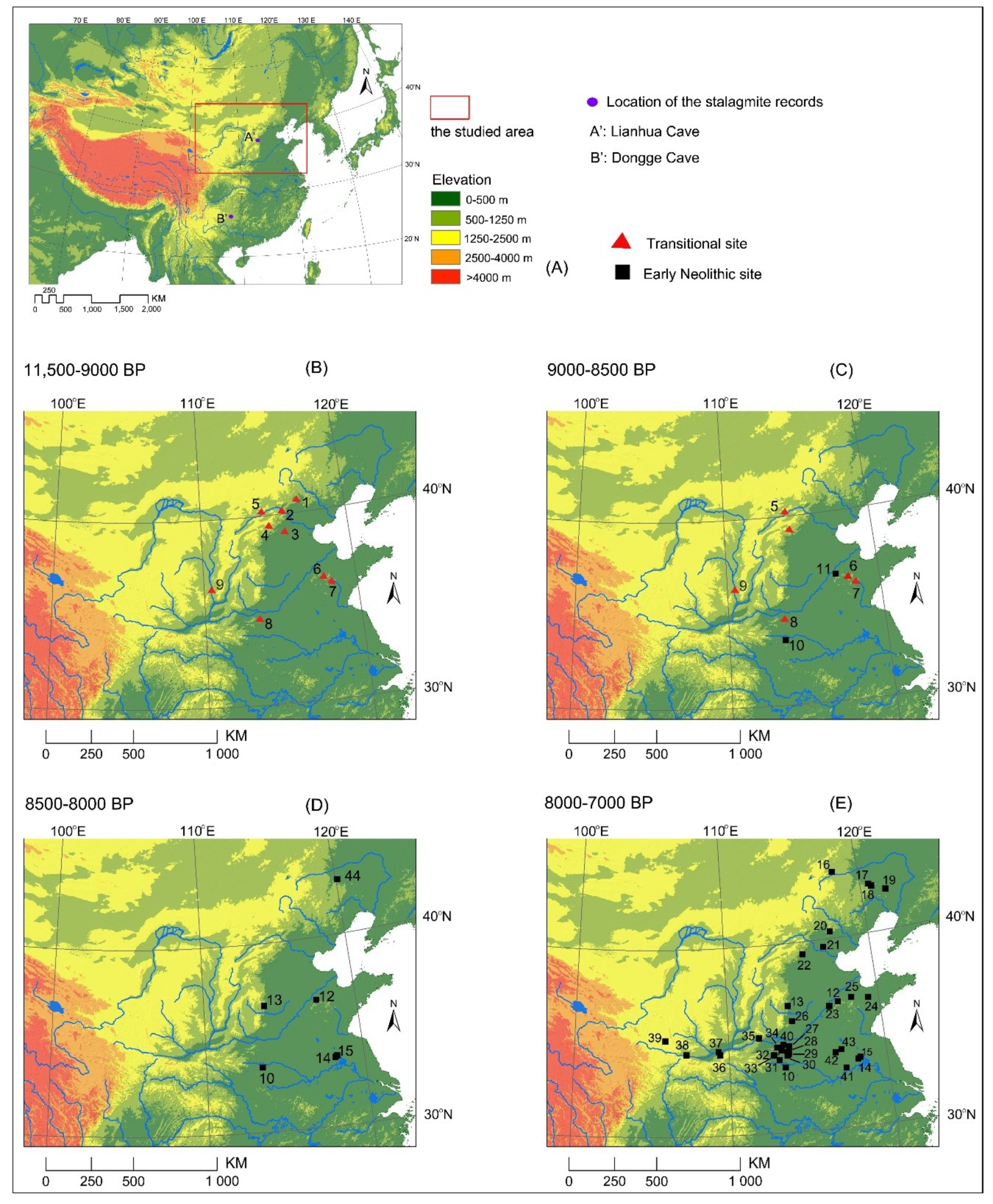
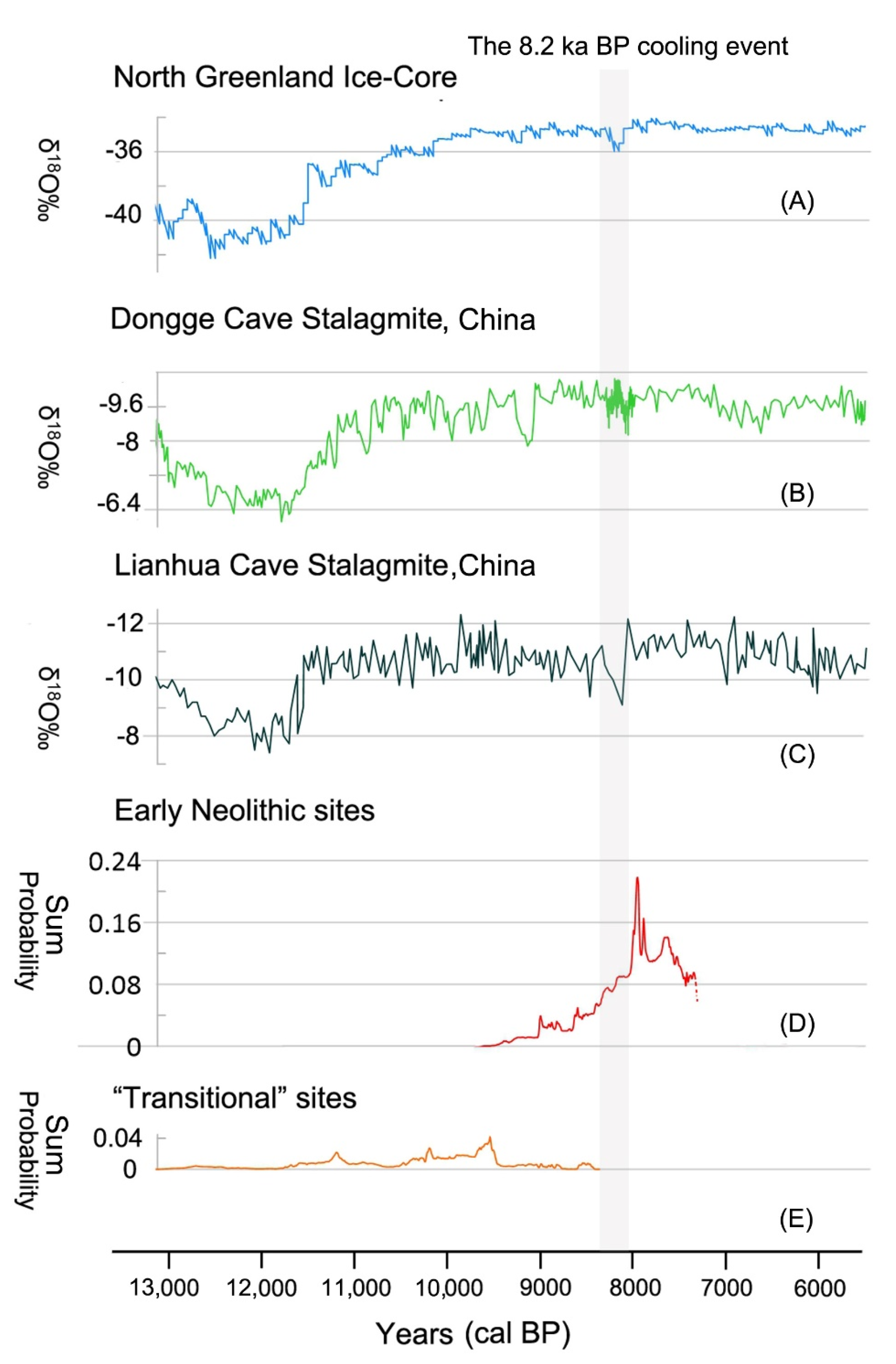
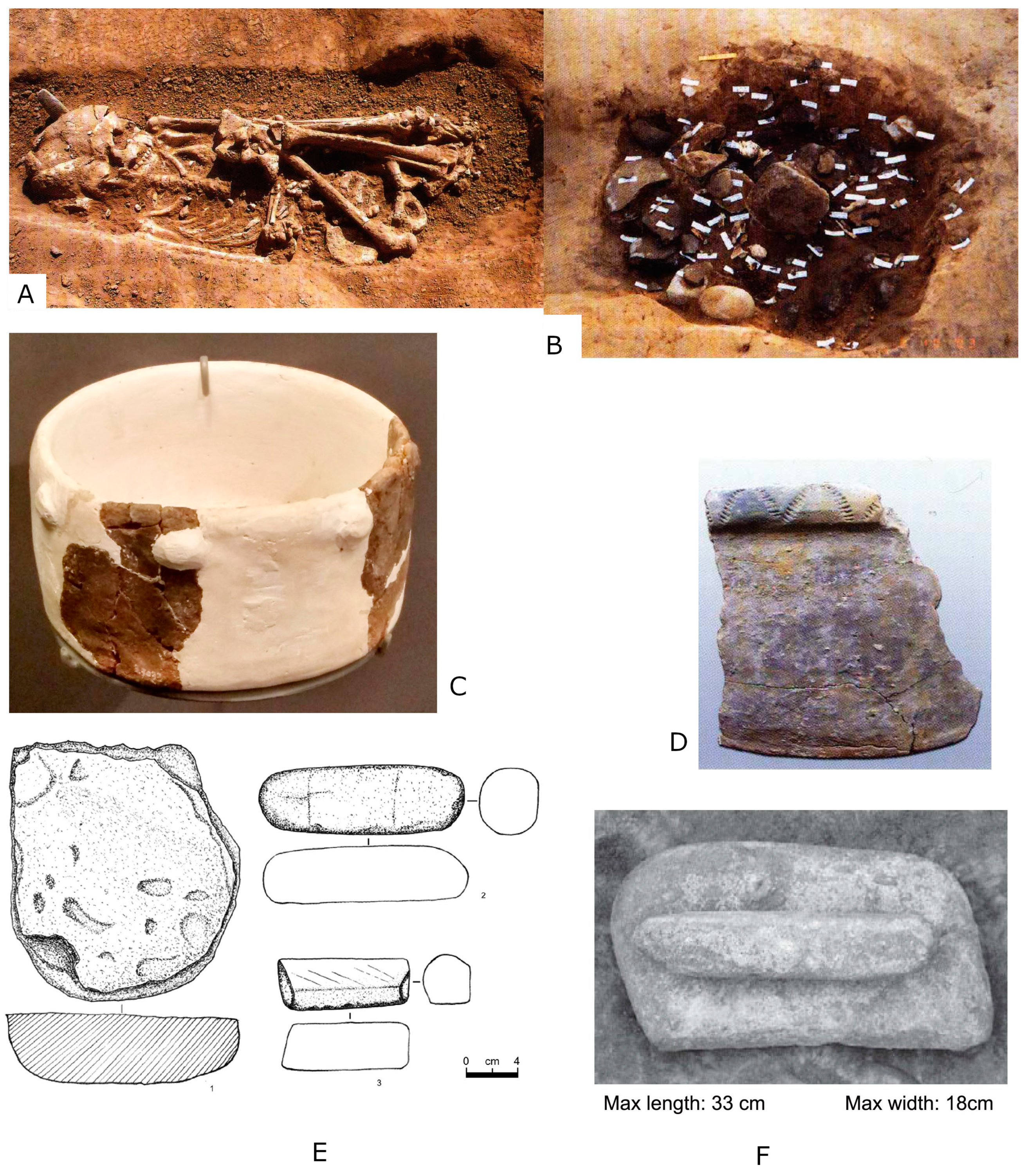
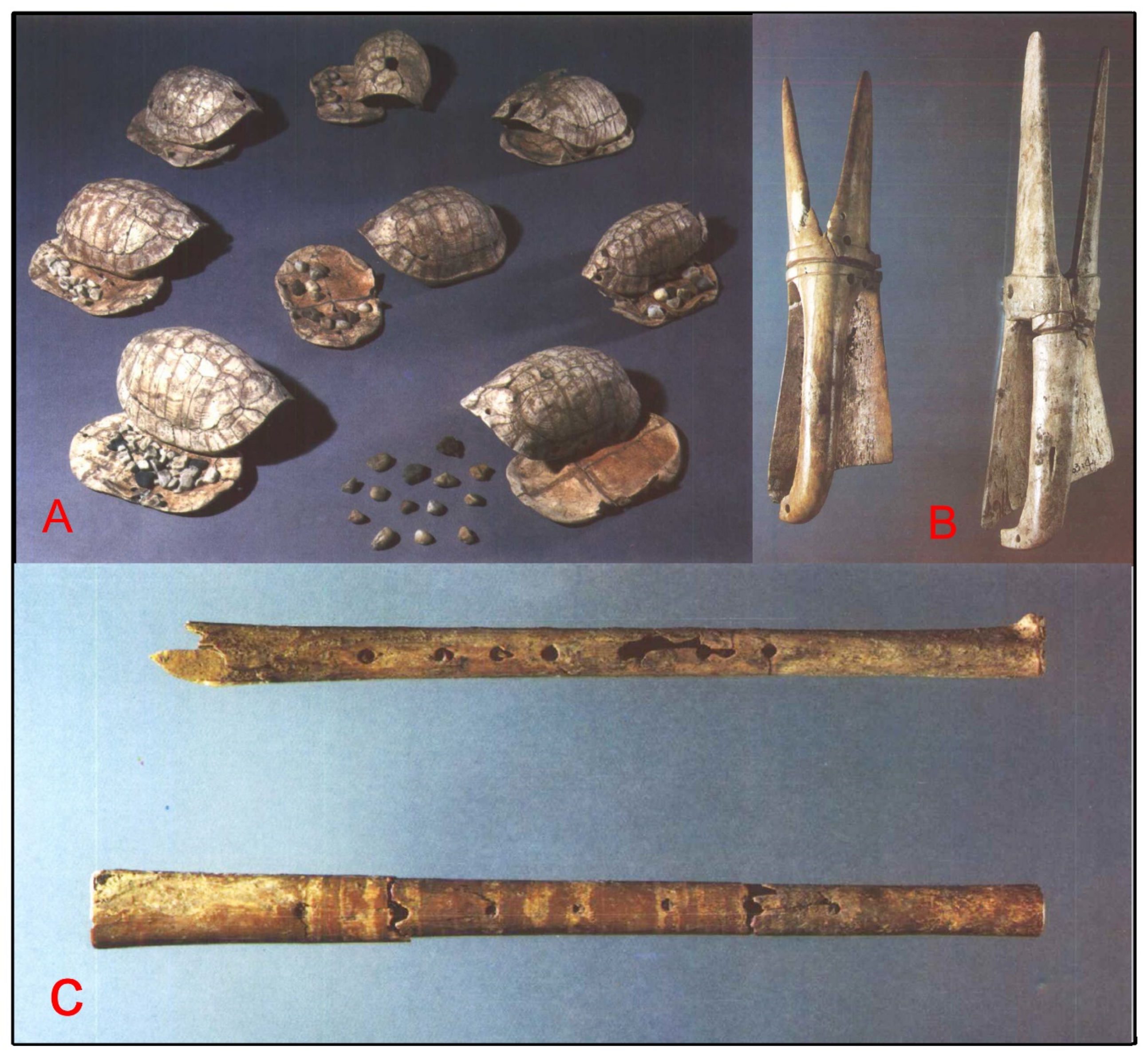
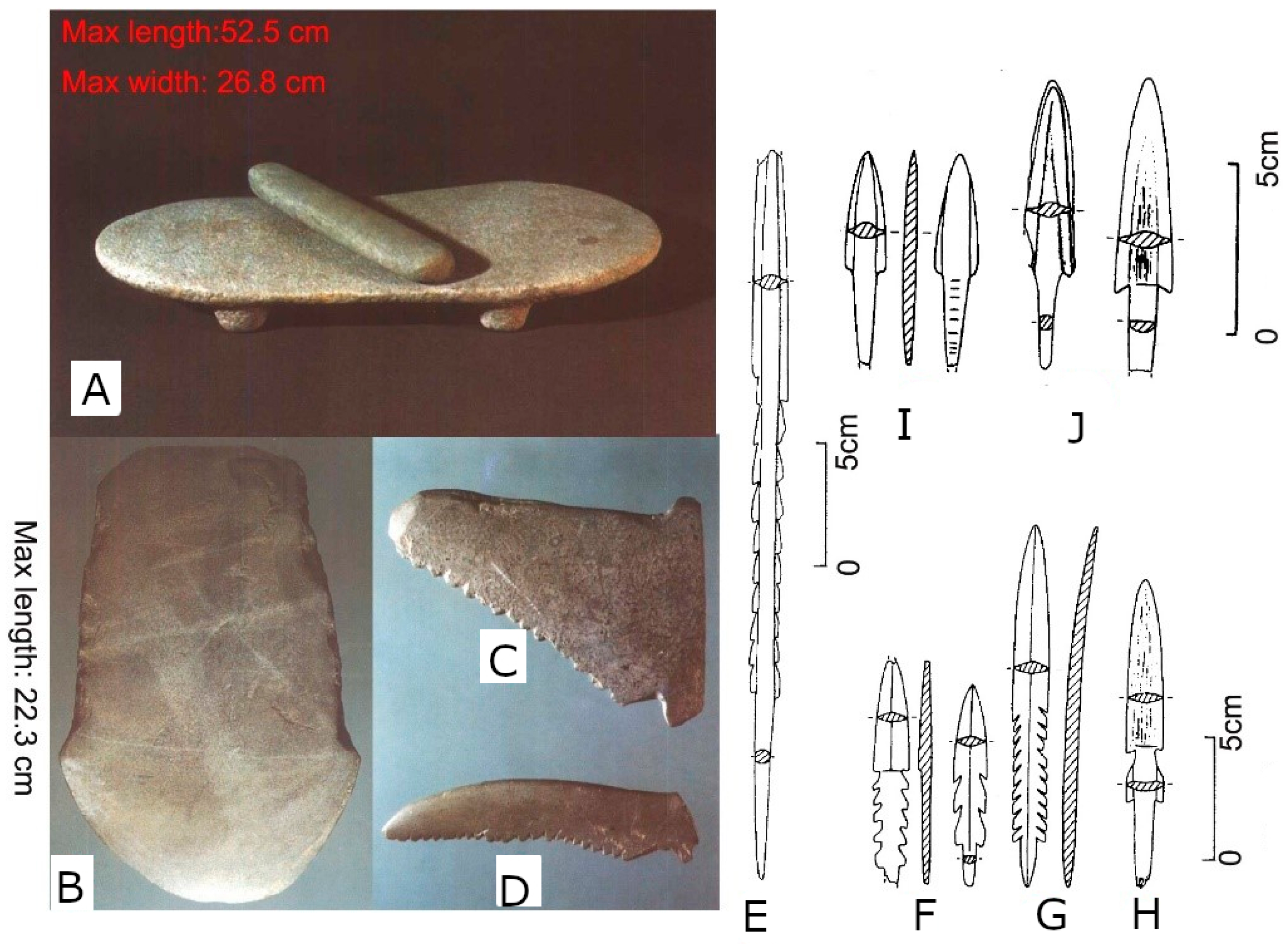
| Coping strategy under climatic deterioration | Archaeological manifestation |
| Increase mobility | Scarcity of the sites; lack of the permanent site structure; thin cultural deposits; portable toolkits. |
| Intensify the resource exploitation of the circumscribed affluent area | Toolkits used for intensive resource extraction; traces of intensified site occupation (thick cultural layer, permanent site structure, etc.); faunal and floral evidence showing the intensified resource use; traces of increased social integration (enlargement of the site, non-utilitarian goods); traces of territoriality (cemetery, defense structure). |
| Long-distance migration | Evidence of cultural transmission; the sharp decline in site numbers contrasted by the dramatic increase in site numbers in another area. |
| Alliance and trans-regional exchange | The presence of exotic goods, mutual cultural influences; stylish cultural markers showing the presence of reciprocal ties. |
© 2020 by the author. Licensee MDPI, Basel, Switzerland. This article is an open access article distributed under the terms and conditions of the Creative Commons Attribution (CC BY) license (http://creativecommons.org/licenses/by/4.0/).
Share and Cite
Zhao, C. The Climate Fluctuation of the 8.2 ka BP Cooling Event and the Transition into Neolithic Lifeways in North China. Quaternary 2020, 3, 23. https://doi.org/10.3390/quat3030023
Zhao C. The Climate Fluctuation of the 8.2 ka BP Cooling Event and the Transition into Neolithic Lifeways in North China. Quaternary. 2020; 3(3):23. https://doi.org/10.3390/quat3030023
Chicago/Turabian StyleZhao, Chao. 2020. "The Climate Fluctuation of the 8.2 ka BP Cooling Event and the Transition into Neolithic Lifeways in North China" Quaternary 3, no. 3: 23. https://doi.org/10.3390/quat3030023
APA StyleZhao, C. (2020). The Climate Fluctuation of the 8.2 ka BP Cooling Event and the Transition into Neolithic Lifeways in North China. Quaternary, 3(3), 23. https://doi.org/10.3390/quat3030023




